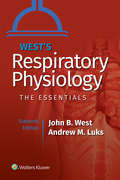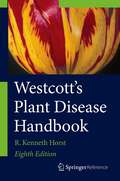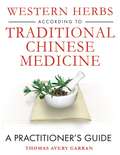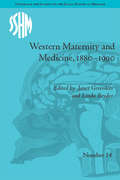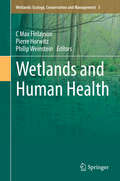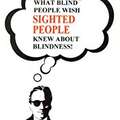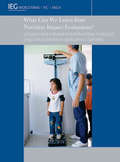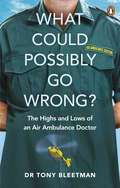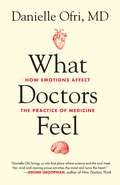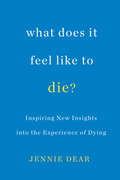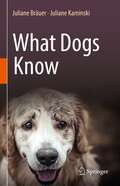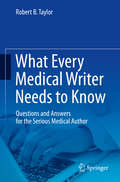- Table View
- List View
West's Pulmonary Pathophysiology: The Essentials
by John B. West Andrew M. LuksReflecting the trusted expertise of Dr. John B. West and Dr. Andrew M. Luks, West’s Pulmonary Pathophysiology: The Essentials, Tenth Edition offers accessible explanations of disease processes that affect the respiratory system. This best-selling companion to West’s Respiratory Physiology: The Essentials, 11th Edition, has served generations of students and practitioners who work with respiratory patients, presenting vital knowledge in a concise, straightforward manner that’s easy to understand. Building on this legacy of success, the tenth edition is updated throughout with the latest clinical perspectives, new images, clinical vignettes, and enhanced USMLE-style review questions to help students excel in today’s changing healthcare practice.
West's Respiratory Physiology: Office Evaluation And Management Of The Adult Patient
by John B. West Andrew M. LuksFor more than 40 years, West’s Respiratory Physiology: The Essentials has remained a critical resource for medical and allied health students learning the basics of respiratory physiology as well as an effective, quick review for residents and fellows in pulmonary medicine, critical care, anesthesiology, and internal medicine as they prepare for licensing and other exams. The eleventh edition incorporates updates in many areas including blood-tissue gas exchange, mechanics, control of ventilation and the respiratory system under stress; all designed to aid clear understanding of pulmonary physiology.
Westborough State Hospital (Images of America)
by Katherine AndersonOn the banks of Lake Chauncy sit the remains of the Westborough Insane Hospital, later known as Westborough State Hospital. Westborough is perhaps best known as the second homeopathic hospital for the insane in the United States and the first example of institutional reuse in the nation. The hospital's unique treatment methods put it squarely at the forefront of mental health treatment, and it was one of the last state hospitals in Massachusetts to close its doors. The pioneering African American pathologist Solomon Carter Fuller spent much of his career at Westborough studying the physical changes made to the brain by Alzheimer's. When it closed in 2010, it was the only state hospital in New England with a dedicated unit for deaf and hard of hearing patients. Though somewhat less infamous than some of its neighbors, Westborough holds a very distinctive place in the history of mental health treatment.
Westcott's Plant Disease Handbook
by R. Kenneth HorstWestcott's Plant Disease is a reference book on diseases which attack plants. Diseases of plants are found on most all plants including trees, shrubs, grasses, forage, fruits, vegetables, garden and greenhouse plants as well as native wild flowers and even weeds. Plant Disease Handbook identifies various types of diseases which are known to invade these plants located throughout North and South America. The recordings include diseases caused by fungi, bacteria, viruses, viroids and nematodes. Causal disease agents are described and illustrated in many cases and diseases and disease control measures are also discussed. A book such as this is never finished since new reports of diseases are continuously reported. This includes new diseases and previously known diseases which occur on both presently recorded plants and on new plants found to be susceptible to diseases. Westcott's Plant Disease provides a reference and guide for identification and control of these plant disease problems.
Western Blotting for the Non-Expert (Techniques in Life Science and Biomedicine for the Non-Expert)
by Biji T. KurienThis book fills the need for a simplified text covering western blotting protocols aimed not just at high school and college students, but the researcher with little to no experience in these techniques. It provides the principles, basic methodology, and tips and tricks to avoiding the common pitfalls of western blotting. The book also introduces simple protocols that can transform western blotting into a fun method, such as sending secret messages on membranes or using nitrocellulose membrane as a canvas for art. In addition to the techniques, this book also covers the history of western blotting, which originated from the development of the blotting of DNA. It then delves into the importance of protein blotting, brought to the fore by the fact that the procedure has been evolving constantly since its inception in 1979, and the fact that the scientific community is faced with a multitude of ways and means of transferring proteins to membranes..
Western Civilization from 1500
by Walter Kirchner Ahmed IbrahimThe Collins College Outline for Western Civilization from 1500 covers all major political, social, and cultural events from the beginning of the "Modern Age" in 1492 through the Reformation, the Age of Enlightenment, Napoleon, the Depression, the World Wars, and the Cold War, continuing up through history's most recent crises and developments in the early twenty-first century. Completely revised and updated by Dr. Ahmed Ibrahim, Western Civilization from 1500 includes practical "test yourself" sections with answers and complete explanations at the end of each chapter. Also included are bibliographies for further reading, as well as maps, timelines, and illustrations.The Collins College Outlines are a completely revised, in-depth series of study guides for all areas of study, including the Humanities, Social Sciences, Mathematics, Science, Language, History, and Business. Featuring the most up-to-date information, each book is written by a seasoned professor in the field and focuses on a simplified and general overview of the subject for college students and, where appropriate, Advanced Placement students. Each Collins College Outline is fully integrated with the major curriculum for its subject and is a perfect supplement for any standard textbook.
Western Herbs according to Traditional Chinese Medicine: A Practitioner's Guide
by Thomas Avery GarranThe first book to exclusively use Chinese medical theories and terminology to guide practitioners of Chinese medicine in the use of Western herbs • Written entirely according to the theory, diagnosis, and treatment paradigm of traditional Chinese medicine (TCM) • Explains how to combine and modify the standard TCM formulas to non-Chinese herbs suitable for Western practitioners • Includes 58 monographs of common Western healing herbs, detailing how each plant is used clinically The ever-growing number of Chinese medicine practitioners in the West has brought about an amalgamation of many styles of Chinese medicine and various other forms of medicine from around the world. This book addresses the increasing demand for knowledge of how to integrate plants from outside the standard Chinese materia medica into the fold of Chinese medical practices in the West. It is the first in-depth guide to using Western herbs exclusively according to the theories, diagnoses, and treatments of traditional Chinese medicine that harmonizes the unique terminology and theories of TCM with other botanical medicines.The book contains 58 monographs, illustrated with full-color photographs, of herbs commonly used by Western herbalists. Each herb is grouped by the basic categorization for medicinals in Chinese medicine, such as Herbs that Resolve the Exterior and Herbs that Regulate Blood. The monographs detail the energetics, function and indication, channels entered, dosage and preparation, and contraindications of each plant. The author also explains how to use the herbs to modify standard formulas used in everyday Chinese herbal medicine, based on his own clinical experience. An appendix of Western Analogs for Chinese Herbs further highlights 40 Chinese medicinals that have related species growing in the West.
Western Maternity and Medicine, 1880-1990 (Studies for the Society for the Social History of Medicine #14)
by Janet Greenlees Linda BryderThe contributors to this collection look into the experiences of women in the Western world going through pregnancy and birth over the last hundred years.
Wetlands and Human Health
by C Max Finlayson Pierre Horwitz Philip WeinsteinThe book addresses the interactions between wetlands and human health and well-being. A key feature is the linking of ecology-health and the targeting of practitioners and researchers. The environmental health problems of the 21st Century cannot be addressed by the traditional tools of ecologists or epidemiologists working in their respective disciplinary silos; this is clear from the emergence and re-emergence of public health and human well-being problems such as cholera pandemics, mosquito borne disease, and episodic events and disasters (e. g. hurricanes). To tackle these problems requires genuine cross-disciplinary collaboration; a key finding of the recently concluded Millennium Ecosystem Assessment when looking at human well-being and ecosystem health. This book brings the disciplines of ecology and health sciences closer to such a synthesis for researchers, teachers and policy makers interested in or needing information to manage wetlands and human health and well-being issues.
What Blind People Wish Sighted People Knew About Blindness! (Revised Edition)
by Harry Martin<P>Harry Martin became blind as the result of an eye disease he contracted while serving in the Navy in 1973. His eye condition began as a case of severe visual impairment, and progressed to total blindness over a period of twenty years. Harry lives with his wife, Carol, and his guide dog, Frankie in Orlando, Florida. <P>THIS BOOK IS A MUST READ FOR ALL SIGHTED PEOPLE! <P>Whether you know a blind person or not, you must read this book. The reader will gain a new understanding of what it is like to be blind, and to go blind. Find out why some blind people can see. Learn how guide dogs work. Discover how blind people do things without sight. If you have a blind relative, friend, spouse, or co-worker; this fascinating book will tell you how to relate to them better. Teachers, this book is an outstanding educational tool. Use it to teach your students all about blindness and the blind.
What Can We Learn from Nutrition Impact Evaluations?
by Martha AinsworthWhat Can We Learn from Nutrition Impact Evaluations? High levels of child malnutrition in developing countries contribute to mortality and have long-term consequences for children's cognitive development and earnings as adults. Recent impact evaluations show that many different interventions have had an impact on children's anthropometric outcomes (height, weight, and birth weight), but there is no simple answer to the question "What works?" to address the problem. Similar interventions have widely different results in different settings, owing to differences in local context, the causes and severity of malnutrition, and the capacity for program implementation. Impact evaluations of programs supported by the Bank, which are generally large-scale, complex interventions in low-capacity settings, show equally variable results. The findings confirm that it should not be assumed that an intervention found effective in a randomized medical setting will have the same effects when implemented under field conditions. There are many robust experimental and quasi-experimental methods for assessing impact under difficult circumstances often found in field settings. The relevance and impact of nutrition impact evaluations could be enhanced by collecting data on service delivery, demand-side behavioral outcomes, and implementation processes to better understand the causal chain and what part of the chain is weak, in parallel with impact evaluations. It is also important to understand better the distribution of impacts, particularly among the poor, and to document better the costs and effectiveness of interventions. High levels of child malnutrition in developing countries are contributing to mortality and present long-term consequences for the survivors. An estimated 178 million children under age 5 in developing countries are stunted (low height for age) and 55 million are wasted (low weight for height). Malnutrition makes children more susceptible to illness and strongly affects child mortality. Beyond the mortality risk in the short run, the developmental delays caused by undernutrition affect children's cognitive outcomes and productive potential as adults. Micronutrient deficiencies-vitamin A, iron, zinc, iodine, for example-are also common and have significant consequences. Progress in reducing malnutrition has been slow: More than half of countries are not on track to achieve the Millennium Development Goal of halving the share of children who are malnourished (low weight for age) by 2015. The food price and financial crises are making achievement of this goal even more elusive. The World Bank has recently taken steps to expand its support for nutrition in response to the underlying need and the increased urgency due to the crises.
What Causes ADHD?
by Joe Seargent Joel NiggSynthesizing a wealth of recent neuropsychological research, this groundbreaking book focuses on the multiple pathways by which attention-deficit/hyperactivity disorder (ADHD) develops. Joel T. Nigg marshals the best available knowledge on what is actually going on in the symptomatic child's brain and why, tracing the intersecting causal influences of genetic, neural, and environmental factors. In the process, the book confronts such enduring controversies as the validity of ADHD as a clinical construct. Specific suggestions are provided for studies that might further refine the conceptualization of the disorder, with significant potential benefits for treatment and prevention.
What Cerebral Blood Flow Tells Us: Measurement and Fluctuation
by Iwao KannoThis book describes the methods for measuring cerebral blood flow (CBF) using radioactive tracers, positron emission tomography (PET) and single photon emission computed tomography (SPECT). Divided into nine chapters, the book covers the attributes, history, theory, and measurement methodology for CBF. It also explains the pathophysiology of brain vascular problems. The temporal and spatial fluctuations of CBF in correspondence with neuronal activity provide us with a new window onto how the brain works. The book details the theories and methodologies for measuring CBF and reviews advances in technology from the era of Kety-Schmidt to the present. The book is targeted at scientists, clinicians and medical students who wish to know more about the principles of tracer kinetics in quantitative measurement of CBF. It discusses the diagnosis of brain pathophysiology via CBF and explores the only partially understood mechanisms that regulate fluctuations in brain function. Written in an accessible manner, the book may also help general readers to understand the fundamental role of CBF in supporting the brain’s activities.
What Could Possibly Go Wrong?: The Highs and Lows of an Air Ambulance Doctor
by Dr Tony Bleetman'During open-chest resuscitations, I've held a non-beating, recently stilled human heart in my hands. And, should you ever get to hold one, you will find the human heart to be rubbery and shockingly light.'What Could Possibly Go Wrong? is a report from the front line of emergency medicine, the first ever account of what it is like to work as an air ambulance doctor. Whether describing cutting through a patient's breastbone to plug a stab wound or barrel rolling a light aircraft at 5,000 feet, Tony Bleetman captures the sheer adrenaline of racing through the sky to save lives. You will learn how to land a helicopter on the side of a mountain, what it means to encounter death every day, and how to perform a tracheotomy in real life (clue: it doesn’t involve a ball-point pen).Funny, shocking and moving, What Could Possibly Go Wrong? is a glimpse at a world where the wrong decision can mean the difference between life and death.Originally published as You Can't Park There: The Highs and Lows of an Air Ambulance Doctor.
What Do I Do?: How to Care for, Comfort, and Commune With Your Nursing Home Elder, Revised and Illustrated Edition
by Katherine Karr Jess KarrHelp families of institutionalized elders with this compassionate and practical manual.
What Doctors Feel
by Danielle OfriA look at the emotional side of medicine--the shame, fear, anger, anxiety, empathy, and even love that affect patient care Physicians are assumed to be objective, rational beings, easily able to detach as they guide patients and families through some of life's most challenging moments. But doctors' emotional responses to the life-and-death dramas of everyday practice have a profound impact on medical care. And while much has been written about the minds and methods of the medical professionals who save our lives, precious little has been said about their emotions. In What Doctors Feel, Dr. Danielle Ofri has taken on the task of dissecting the hidden emotional responses of doctors, and how these directly influence patients. How do the stresses of medical life--from paperwork to grueling hours to lawsuits to facing death--affect the medical care that doctors can offer their patients? Digging deep into the lives of doctors, Ofri examines the daunting range of emotions--shame, anger, empathy, frustration, hope, pride, occasionally despair, and sometimes even love--that permeate the contemporary doctor-patient connection. Drawing on scientific studies, including some surprising research, Dr. Danielle Ofri offers up an unflinching look at the impact of emotions on health care. With her renowned eye for dramatic detail, Dr. Ofri takes us into the swirling heart of patient care, telling stories of caregivers caught up and occasionally torn down by the whirlwind life of doctoring. She admits to the humiliation of an error that nearly killed one of her patients and her forever fear of making another. She mourns when a beloved patient is denied a heart transplant. She tells the riveting stories of an intern traumatized when she is forced to let a newborn die in her arms, and of a doctor whose daily glass of wine to handle the frustrations of the ER escalates into a destructive addiction. But doctors don't only feel fear, grief, and frustration. Ofri also reveals that doctors tell bad jokes about "toxic sock syndrome," cope through gallows humor, find hope in impossible situations, and surrender to ecstatic happiness when they triumph over illness. The stories here reveal the undeniable truth that emotions have a distinct effect on how doctors care for their patients. For both clinicians and patients, understanding what doctors feel can make all the difference in giving and getting the best medical care. Praise for Danielle Ofri "The world of patient and doctor exists in a special sacred space. Danielle Ofri brings us into that place where science and the soul meet. Her vivid and moving prose enriches the mind and turns the heart." --Jerome Groopman, author of How Doctors Think "Danielle Ofri is a finely gifted writer, a born storyteller as well as a born physician." --Oliver Sacks, author of Awakenings "Danielle Ofri ... is dogged, perceptive, unafraid, and willing to probe her own motives, as well as those of others. This is what it takes for a good physician to arrive at the truth, and these same qualities make her an essayist of the first order." --Abraham Verghese, author of Cutting for Stone "Danielle Ofri has so much to say about the remarkable intimacies between doctor and patient, about the bonds and the barriers, and above all about how doctors come to understand their powers and their limitations." --Perri Klass, MD, author of A Not Entirely Benign Procedure "Her writing tumbles forth with color and emotion. She demonstrates an ear for dialogue, a humility about the limits of her medical training, and an extraordinary capacity to be touched by human suffering." --Jan Gardner, Boston Globe From the Hardcover edition.
What Doctors Feel: How Emotions Affect the Practice of Medicine
by Danielle OfriA look at the emotional side of medicine—the shame, fear, anger, anxiety, empathy, and even love that affect patient care Physicians are assumed to be objective, rational beings, easily able to detach as they guide patients and families through some of life’s most challenging moments. But doctors’ emotional responses to the life-and-death dramas of everyday practice have a profound impact on medical care. And while much has been written about the minds and methods of the medical professionals who save our lives, precious little has been said about their emotions. In What Doctors Feel, Dr. Danielle Ofri has taken on the task of dissecting the hidden emotional responses of doctors, and how these directly influence patients. How do the stresses of medical life—from paperwork to grueling hours to lawsuits to facing death—affect the medical care that doctors can offer their patients? Digging deep into the lives of doctors, Ofri examines the daunting range of emotions—shame, anger, empathy, frustration, hope, pride, occasionally despair, and sometimes even love—that permeate the contemporary doctor-patient connection. Drawing on scientific studies, including some surprising research, Dr. Danielle Ofri offers up an unflinching look at the impact of emotions on health care. With her renowned eye for dramatic detail, Dr. Ofri takes us into the swirling heart of patient care, telling stories of caregivers caught up and occasionally torn down by the whirlwind life of doctoring. She admits to the humiliation of an error that nearly killed one of her patients and her forever fear of making another. She mourns when a beloved patient is denied a heart transplant. She tells the riveting stories of an intern traumatized when she is forced to let a newborn die in her arms, and of a doctor whose daily glass of wine to handle the frustrations of the ER escalates into a destructive addiction. But doctors don’t only feel fear, grief, and frustration. Ofri also reveals that doctors tell bad jokes about “toxic sock syndrome,” cope through gallows humor, find hope in impossible situations, and surrender to ecstatic happiness when they triumph over illness. The stories here reveal the undeniable truth that emotions have a distinct effect on how doctors care for their patients. For both clinicians and patients, understanding what doctors feel can make all the difference in giving and getting the best medical care.
What Does It Feel Like to Die?: Inspiring New Insights into the Experience of Dying
by Jennie DearA compassionate, honest, and illuminating look at the dying process . . . As a long-time hospice volunteer, Jennie Dear has helped countless patients, families, and caregivers cope with the many challenges of the dying process. Inspired by her own personal journey with her mother’s long-term illness, Dear demystifies the experience of dying for everyone whose lives it touches. She spoke to doctors, nurses, and caregivers, as well as families, friends, and the patients themselves. The result is a brilliantly researched, eye-opening account that combines the latest medical findings with sensitive human insights to offer real emotional support and answers to some of the questions that affect us all. Does dying hurt?A frank discussion of whether dying has to be painful—and why it sometimes is even when treatment is readily available. Is there a better way to cope with dying?Comforting stories of people who found peace in the face of death , and some of the expert methods they used for getting there. The last few hours: What does it feel like to die?Powerful glimpses from dedicated professionals into the physical experiences of people in their final moments—plus comforting words and insights from those who are there to help.
What Does it Mean to be Human? Life, Death, Personhood and the Transhumanist Movement (Anticipation Science #3)
by D. John DoyleThis book is a critical examination of the philosophical and moral issues in relation to human enhancement and the various related medical developments that are now rapidly moving from the laboratory into the clinical realm. In the book, the author critically examines technologies such as genetic engineering, neural implants, pharmacologic enhancement, and cryonic suspension from transhumanist and bioconservative positions, focusing primarily on moral issues and what it means to be a human in a setting where technological interventions sometimes impact strongly on our humanity. The author also introduces the notion that death is a process rather than an event, as well as identifies philosophical and clinical limitations in the contemporary determination of brain death as a precursor to organ procurement for transplantation. The discussion on what exactly it means to be dead is later applied to explore philosophical and clinical issues germane to the cryonics movement. Written by a physician/ scientist and heavily referenced to the peer-reviewed medical and scientific literature, the book is aimed at advanced students and academics but should be readable by any intelligent reader willing to carry out some side-reading. No prior knowledge of moral philosophy is assumed, as the various key approaches to moral philosophy are outlined early in the book.
What Doesn't Kill You: A Life with Chronic Illness—Lessons from a Body in Revolt
by Tessa Miller"Should be read by anyone with a body. . . . Relentlessly researched and undeniably smart."—The New York TimesNamed one of BuzzFeed's "Best Books of 2021"What Doesn't Kill You is the riveting account of a young journalist’s awakening to chronic illness, weaving together personal story and reporting to shed light on living with an ailment forever.Tessa Miller was an ambitious twentysomething writer in New York City when, on a random fall day, her stomach began to seize up. At first, she toughed it out through searing pain, taking sick days from work, unable to leave the bathroom or her bed. But when it became undeniable that something was seriously wrong, Miller gave in to family pressure and went to the hospital—beginning a years-long nightmare of procedures, misdiagnoses, and life-threatening infections. Once she was finally correctly diagnosed with Crohn’s disease, Miller faced another battle: accepting that she will never get better.Today, an astonishing three in five adults in the United States suffer from a chronic disease—a percentage expected to rise post-Covid. Whether the illness is arthritis, asthma, Crohn's, diabetes, endometriosis, multiple sclerosis, ulcerative colitis, or any other incurable illness, and whether the sufferer is a colleague, a loved one, or you, these diseases have an impact on just about every one of us. Yet there remains an air of shame and isolation about the topic of chronic sickness. Millions must endure these disorders not only physically but also emotionally, balancing the stress of relationships and work amid the ever-present threat of health complications.Miller segues seamlessly from her dramatic personal experiences into a frank look at the cultural realities (medical, occupational, social) inherent in receiving a lifetime diagnosis. She offers hard-earned wisdom, solidarity, and an ultimately surprising promise of joy for those trying to make sense of it all.
What Dogs Know
by Juliane Bräuer Juliane KaminskiMy dog understands me! At least, many dog owners think so. New scientific studies actually show that dogs understand a lot about us humans. For example, they can figure out what humans can and cannot see. Some dogs can even distinguish large numbers of toys by name, like Rico, the internationally famous Border collie.But do dogs also understand our emotions? Can they grasp cause and effect relationships? What fascinates us humans about dogs? Is it only the proverbial ‘puppy dog eyes’ that make dogs look sympathetic? Or is it the fact that these animals have grown very well-attuned to humans and are willing to cooperate with them?In a total of ten chapters, Juliane Bräuer and Juliane Kaminski present the results of the most important scientific studies of the last twenty years on dog cognition.
What Don't Kill Me Just Makes Me Strong: A Memoir
by Stewart FranckeThe Detroit music legend and founder of the Stewart Francke Leukemia Foundation shares his inspiring story of illness, faith, and the drive to survive. In this candid survival memoir, Stewart Francke recounts his remarkable journey with leukemia through a bone marrow transplant, complications, and eventual recovery. Understanding that his survival makes him part of the &“lucky unlucky,&” the young father and renowned musician finds the silver lining—and then some—in his struggle. Francke&’s story from initial biopsy to full recovery is often harrowing. Yet it is in the darkest moments that he learns important lessons about survival. Coming to understand that faith is a choice, he also realizes that only death is irrevocable. All else either makes us stronger or becomes part of the gift of life. Beginning each chapter with a brief but powerful lesson in living, Francke&’s singular story of illness, faith, and family is also a universal guide for facing adversity.
What Every Medical Writer Needs to Know
by Robert B. TaylorThis book presents must-know facts generally not covered in "How To" books about medical writing. Every medical writer, whether a beginner or veteran, needs answers to questions many might not even know to ask. How does your personality type influence your writing behavior, and what can you do to make writing easier for you? What should you ask before agreeing to co-author an article for publication or write a book chapter? What are some of the current issues regarding copyright and plagiarism that authors may face? What has research discovered about the quotations and references found in journal articles? What do you need to know about open access journals and predatory publishers? Dr. Taylor tells some surprising truths about medical publishing, including possible sources of peer review bias and some alarming influences on what ends up in print. He also relates little-known stories about renowned medical writers such as Sir William Osler, William Carlos Williams and Elisabeth Kübler-Ross and the origins of some of medicine's classic publications. What Every Medical Writer Needs to Know provides information vital for every health care professional who aspires to write for others to read: academicians and practicing physicians; nurses, nurse practitioners and physician assistants; and professional medical and scientific writers.
What Every Woman Needs to Know About Her Gut: The FLAT GUT Diet Plan
by Barbara Ryan Elaine McGowan* Digestive problems* Bloating* Diarrhoea* Constipation* PainDo you identify with these symptoms? Does your digestive system feel like your enemy? Is your unpredictable gut a source of embarrassment or fear, or is it holding you back?If you're a woman who's answered 'yes' to any of the above, you're not alone. More than two-thirds of people with IBS are female; other gut problems are also more common in women. And your needs are very specific.YOU NEED: Clear, accessible information about and insight into what female hormones can do to gut healthYOU NEED: Expert guidance from a consultant gastroenterologist and a clinical dietitian and nutritionistYOU NEED: Stepped, manageable strategies to take control of your troublesome gutYOU NEED: A diet plan that focuses on your specific requirements, which is flexible, achieveable and sustainableYOU NEED: Easy-to-follow recipes that are gut-friendly, delicious and restore your digestive healthYOU NEED THIS BOOK!Professor Barbara Ryan and Elaine McGowan, RD, are The Gut Experts (@thegutexperts and www.thegutexperts.com) and have treated over 60,000 patients with every kind of digestive condition and nutritional requirement. They are bringing their expertise and insights to you in this easy-to-digest book.
What Every Woman Needs to Know About Her Gut: The FLAT GUT Diet Plan
by Barbara Ryan Elaine McGowan* Digestive problems* Bloating* Diarrhoea* Constipation* PainDo you identify with these symptoms? Does your digestive system feel like your enemy? Is your unpredictable gut a source of embarrassment or fear, or is it holding you back?If you're a woman who's answered 'yes' to any of the above, you're not alone. More than two-thirds of people with IBS are female; other gut problems are also more common in women. And your needs are very specific.YOU NEED: Clear, accessible information about and insight into what female hormones can do to gut healthYOU NEED: Expert guidance from a consultant gastroenterologist and a clinical dietitian and nutritionistYOU NEED: Stepped, manageable strategies to take control of your troublesome gutYOU NEED: A diet plan that focuses on your specific requirements, which is flexible, achieveable and sustainableYOU NEED: Easy-to-follow recipes that are gut-friendly, delicious and restore your digestive healthYOU NEED THIS BOOK!Professor Barbara Ryan and Elaine McGowan, RD, are The Gut Experts (@thegutexperts and www.thegutexperts.com) and have treated over 60,000 patients with every kind of digestive condition and nutritional requirement. They are bringing their expertise and insights to you in this easy-to-digest book.

